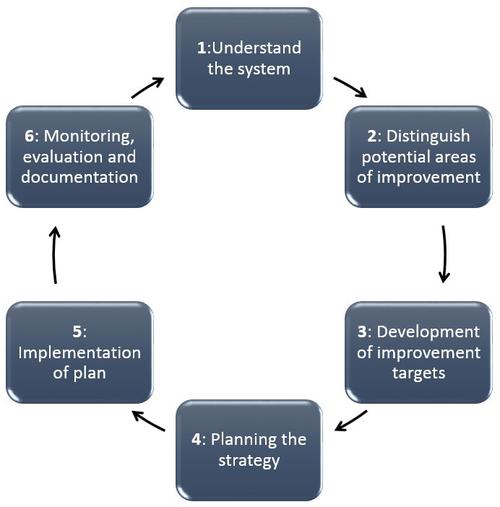Step 1: The first step is to understand the system which should be improved. This includes outlining the study area, identifying the geographical features (waterbodies, terrain, settlements, etc.), investigate the socioeconomic conditions (e.g. income, agricultural and industrial distribution and stakeholder) and looking at the legislation. Determine the sources of water (rainfall, surface water, ground water and/or wastewater) and its purification, distribution, use, collection, treatment, reuse as well as the handling of solid waste and nutrients. The goal is to follow water and nutrient cycles in your system in order to identify root causes of problems (e.g. overuse, pollution, mismanagement, weak political and legal framework) and which problems may be linked. (Pain 2012a)
Step 2: The next step is to distinguish potential areas of improvement and opportunities for synergy within water and nutrient cycles. (Pain 2012a)
Step 3: Development of different scenarios to achieve the improvement targets. A frame strategy is developed for each of the scenarios. These strategies and scenarios are then reviewed and analysed to see which will best achieve the targets, given all the challenges, constraints and opportunities faced at that time. (UNEP 2012)
Step 4: Once the targets and the best strategy have been agreed upon, the planning process can begin. The Plan will include a budget, schedule, roles and responsibilities, targets, and indicators to be used for monitoring and evaluation. (UNEP 2012)
Step 5: The Plan is implemented in a coordinated manner. There are often obstacles to implementation due to gaps in technical skills, inadequate funding, inadequate mechanisms for coordination and the roles and responsibilities of the various stakeholders, to mention but a few. (UNEP 2012)
Step 6: Monitoring, evaluation and documentation of actions identified in the Plan are carried out at the scheduled time, in accordance with the planned budget and responsibilities. It also provides stakeholders the opportunity to reflect on the progress achieved in order to determine if the original plan needs refinement, and to identify lessons learned in implementing the plan. These lessons will provide opportunities for further refinement of the strategy and/or for informing further refinement of existing policy, institutional and legal frameworks for water resources management. (UNEP 2012)
